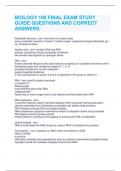PRN 1032 Client Centered Care
Exam 2 | Questions and
Answers Graded A+ | Latest
2024
What is BMR (Basal Metabolic Rate)? - Correct Answer - The
amount of energy needed to maintain the body at rest is called
the basal metabolic rate (BMR). We express it in kilocalories per
day (kcal)
What are the 5 guidelines of the Dietary Guidelines?
- Correct Answer - Follow a healthy eating pattern across the
lifespan.
Focus on variety, nutrient density, and amount.
Limit calories from added sugars and saturated fats and reduce
sodium intake.
Shift to healthier food and beverage choices.
Support healthy eating patterns for all.
,What does the musculoskeletal system consist of? - Correct
Answer - Bones
Cartilage
Tendons
ligaments
muscles
What are the functions of the Musculoskeletal system? - Correct
Answer - These structures all work together to support the body
and produce movement. Other functions of the skeleton are to
protect internal organs from mechanical injury, protect the bone
marrow, and store excess calcium in the bones (Scanlon &
Sanders, 2015). In addition to body movement, skeletal muscles
produce heat which helps maintain body temperature. Skeletal
muscles also work with other body systems involved in
movement, including the nervous, respiratory, and circulatory
systems
,What are vitamins? - Correct Answer - Non-caloric organic
compounds needed in small quantities to assist in such functions
as growth, maintenance, and repair.
What are two types of vitamins? - Correct Answer - fat soluble
(A, D, E, K)
water soluble (Vitamin c, thiamin, riboflavin, niacin, pantothenic
acid, biotin, vitamin B6, folate and vitamin B12)
What are the differences between the two types of vitamins? -
Correct Answer - Water soluble is not stored in the body, and fat
soluble is stored in the body.
Vitamin A Food sources - Correct Answer - Chicken livers, sweet
potato w/skin, carrots, spinach, pumpkin.
Vitamin A Results of deficiency - Correct Answer - Night
blindness, exophthalmia, and decreased immunity.
, Vitamin D food sources - Correct Answer - Tuna fish, whole or
fortified milk, fortified soy milk, fortified cereal
Vitamin D Results of deficiency - Correct Answer - Rickets,
osteoma Lacia, osteoporosis
Vitamin E Food sources - Correct Answer - Fortified cereal,
sunflower seeds, tomatoes sauce, safflower oil
Vitamin E results of deficiency - Correct Answer - anemia,
nervous system disorders
Vitamin K Food sources - Correct Answer - Green leafy veggies,
tuna fish, tomato sauce
Vitamin K results of deficiency - Correct Answer - Hemorrhagic
disease (newborn), defective blood clotting
Vitamin C food Sources - Correct Answer - Citrus fruits, berries,
broccoli, cabbage, chili peppers, tomatoes





